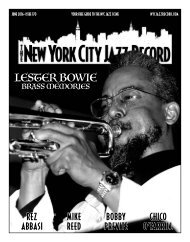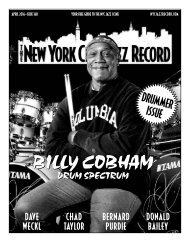Create successful ePaper yourself
Turn your PDF publications into a flip-book with our unique Google optimized e-Paper software.
A Love Supreme: The Complete Masters<br />
John Coltrane (Impulse!-Verve)<br />
by George Kanzler<br />
Returning from overseas in the spring of 1965, one of<br />
the first sounds this reviewer heard from a phonograph<br />
in the Southern States barracks that was then home<br />
was saxophonist John Coltrane’s album A Love Supreme.<br />
Later in the decade, I would hear it in Africa—on the<br />
radio and referenced by Highlife and AfroPop<br />
musicians—and in America on sound systems during<br />
rock concert intermissions. And guitarist Carlos<br />
Santana’s experience, recounted in the notes written<br />
by Coltrane scholar Ashley Kahn, of first having been<br />
turned on to this music while smoking pot, was not an<br />
unusual one in the ‘60s-70s.<br />
For A Love Supreme is one of those very rare<br />
albums, or any artifact for that matter, that transcends<br />
labels and genres. It was one of the avatars of the<br />
cultural zeitgeist that has come to be known as The<br />
Sixties. Beyond its ‘spiritual’ influence—echoing<br />
worship and mysticism—so new to jazz, its core<br />
musical phrases and riffs were disseminated far and<br />
wide, popping up in rock music as diverse as Santana<br />
and Steely Dan. And thanks to the FCC’s “FM nonduplication<br />
rule” issued the year before, the album<br />
also became part of the new free-form FM radio format.<br />
Here, in its 50th anniversary year of release, we<br />
have the complete original LP expanded to two CDs<br />
(three LPs) or, in a deluxe version of three CDs and<br />
including a booklet of photos, Coltrane’s handwritten<br />
charts and even fascsimile of the reel boxes. The latter<br />
includes the only recording of a live performance of<br />
the complete A Love Supreme, from the French Antibes<br />
Jazz Festival (Jul. 26th, 1965) on the third CD. Added to<br />
the original LP music on the first CD are two monaural<br />
“reference” tracks given to Coltrane of the last two<br />
parts of the suite. CD 2 contains both alternate takes<br />
and overdubs from the quartet sessions, including the<br />
vocal overdubs of Part I and the undubbed version of<br />
Part IV (Coltrane added his own alto saxophone to the<br />
tenor saxophone coda on the released version). The<br />
quartet session was Dec. 9th, 1964; the next day<br />
Coltrane brought a sextet in and recorded four takes<br />
and two breakdowns of Part I— “Acknowledgement”,<br />
which makes up the rest of the second disc.<br />
The inclusion of alternate takes and the concert<br />
recording here further emphasize the singular<br />
achievement of the original album. There is a<br />
concentrated focus to the music achieved in the<br />
legendary Van Gelder Studio in Englewood Cliffs, NJ<br />
that day because, more than was usual for Coltrane, he<br />
oversaw every detail of the performance. The<br />
overdubbing of the vocal chant—associating words,<br />
however brief, with the music cannot be discounted as<br />
a major reason for the album’s astounding popular<br />
success—demonstrates that detail, as does hearing<br />
“Part IV—Psalm” before Coltrane added the<br />
overdubbed alto, which gives the final version the<br />
choir-like quality of a hymn.<br />
The roles of his sidemen were also carefully<br />
monitored, with bassist Jimmy Garrison repeating the<br />
1-2-5 “love supreme” motif introduced in “Part I—<br />
Acknowledgement” toward the conclusion of “Part<br />
III—Pursuance”. Elvin Jones’ drumming was also more<br />
directed than was usual on other quartet sessions and<br />
performances, as Coltrane seems to have restricted his<br />
sonic palette and range, so that certain tones and<br />
timbres, like tympani (probably tuned toms) or tight<br />
snare and/or cymbal rolls dominate at specific times.<br />
Adding tenor saxophonist Archie Shepp and bassist<br />
Art Davis to the basic quartet (pianist McCoy Tyner<br />
rounded out the group) the next day in the studio,<br />
Coltrane tried more elaborate approaches to “Part I—<br />
Acknowledgement” and the results are fascinating on<br />
their own. But we should be grateful he decided not to<br />
tamper with the concentrated, almost austere quartet<br />
version that became the classic album.<br />
How focused and singular that album is becomes<br />
even more clear when compared to the live recording<br />
of the work from Antibes, a fine example of the passion<br />
and energy of the Coltrane Quartet typical of other live<br />
recordings, but not much related to the iconic sound of<br />
the studio LP.<br />
For more information, visit vervemusicgroup.com<br />
the first people journalists would contact when they<br />
needed an authority on jazz-related topics. In addition<br />
to his work in jazz education, Taylor was a superb<br />
pianist and he is in fine form on this 1969 session,<br />
released by MPS Records in Europe as Sleeping Bee but<br />
titled Billy Taylor Today when Prestige rereleased it in<br />
the United States.<br />
Stylistically, Taylor favored a melodic but hardswinging<br />
approach along the lines of Wynton Kelly,<br />
Tommy Flanagan, Hank Jones and Red Garland, all of<br />
whom are valid comparisons on Sleeping Bee. Taylor<br />
leads a trio of bassist Ben Tucker and drummer Grady<br />
Tate, the same band for his 1968 session I Wish I Knew<br />
How It Would Feel to Be Free. Now 83, Tate is the trio’s<br />
lone survivor. Tucker, who played with everyone from<br />
guitarist Grant Green to flutist Herbie Mann, died in<br />
2013.<br />
The performances are straightahead hardbop and<br />
include memorable Taylor originals such as the<br />
exuberant “Don’t Go Down South”, sentimental<br />
“Theodora” and infectious blues “Bye, Y’all”. Taylor is<br />
equally appealing on the program’s non-originals,<br />
which range from Oscar Brown, Jr.’s “Brother, Where<br />
Are You?” to Tin Pan Alley standards by Harry Warren<br />
(“There Will Never Be Another You”) and Harold Arlen<br />
(“A Sleeping Bee”).<br />
It’s no secret that Taylor was a major admirer of<br />
Erroll Garner, who he respected as both a pianist and<br />
composer. And his affection for Garner’s work comes<br />
through on an inspired performance of “Le Petite<br />
Mambo”, a Garner blues with an AfroCuban influence.<br />
Taylor’s improvisations acknowledge Garner’s<br />
distinctive style, although not at the expense of his<br />
own pianistic identity.<br />
For more information, visit mps-music.com<br />
Sleeping Bee<br />
Billy Taylor (MPS-Edel)<br />
by Alex Henderson<br />
Dr. Billy Taylor, who was 89 when he died of a heart<br />
attack in Manhattan five years ago on Dec. 28th, 2010,<br />
went down in history as one of jazz’ most articulate<br />
and passionate cheerleaders. The educator/broadcaster<br />
knew the history of jazz inside and out and was one of<br />
THE NEW YORK CITY JAZZ RECORD | DECEMBER 2015 29




